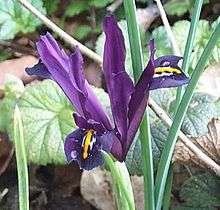Iris histrioides
| Iris histrioides | |
|---|---|
 | |
| Scientific classification | |
| Kingdom: | Plantae |
| (unranked): | Angiosperms |
| (unranked): | Monocots |
| Order: | Asparagales |
| Family: | Iridaceae |
| Subfamily: | Iridoideae |
| Tribe: | Irideae |
| Genus: | Iris |
| Subgenus: | Hermodactyloides |
| Species: | I. histrioides |
| Binomial name | |
| Iris histrioides (G.F. Wilson) S. Arn. | |
| Synonyms | |
| |
Iris histrioides, is a species in the genus Iris, and in the subgenus of Hermodactyloides.It is native to Turkey, and has blue scented flowers.
Description
It has leaves that grow up to 45 cm high. The flower is about 6 – 7 cm tall. It is a bulbous perennial that blooms in early spring, normally January.[2]
It has flowers that vary in shade from bright blue to violet.[3]
Once the bulb has been planted, it can take many years to reach flowering size. Also it has the habit of the main bulb splitting into many bulblets, that can take many years to reach flowering size.[4]
Taxonomy
It is sometimes known as the 'Orchis Iris'.[5][6]
It was described and published by G.F.Wilson in 1892.[7]
Distribution and habitat
It is native to Europe.
Range
It is found in Turkey.[8]
Habitat
It commonly grows on the mountain slopes at an altitude of 1,500 metres (4,900 ft) above sea level.[8]
Conservation
It was on the 1997 IUCN Red List of Threatened Plants.[9]
Cultivation
It is hardy to USDA Zone: 5 - 8.[10]
It is suitable for a rock or gravel garden or front of border.[11]
Cultivars known
- Iris 'George' (purple),[8]* Iris 'Katharine Hodgkin'(light blue standards, pale yellow falls, a 1960s hybrid of Iris histrioides and the primrose-yellow Iris winogradowii).[12]
- Iris 'Harmony' (light blue, a hybrid between I. histrioides and Iris reticulata)[8]
- Iris 'Joyce' (deep blue falls and sky blue standards)[13]
- Iris 'Lady Beatrice Stanley' (pale-blue flowers and a mass of dark spotting on the falls)[8]
- Iris 'Major' (royal blue) [8][14]
- Iris 'Pauline'(light blue, a hybrid between I. histrioides and I. reticulata)[8]
 Iris histrioides f. major
Iris histrioides f. major Variety 'Gerorge'
Variety 'Gerorge'- Variety 'Katharine Hodgkin'
Subspecies
- Iris histrioides var. sophenensis also, from Turkey is deep violet-blue with little veining or spotting, narrow petals and a yellow ridge.[15]
Toxicity
Like many other irises, most parts of the plant are poisonous (rhizome and leaves), if mistakenly ingested can cause stomach pains and vomiting. Also handling the plant may cause a skin irritation or an allergic reaction.[16]
Uses
Iris histrioides (Foster) and Iris persica L. have been used as food ingredients in Turkey.[17]
References
- ↑ "Iris histrioides (G.F.Wilson) S.Arn. is an accepted name". theplantlist.org (The Plant List). Retrieved 7 April 2015.
- ↑ Stebbings, Geoff (1997). The Gardener's Guide to Growing Irises. Newton Abbot: David and Charles. p. 66. ISBN 0715305395.
- ↑ Christopher Bricknell (Editor)Gardeners' Encyclopedia of Plants and Flowers 7th Edition (1994), p. 612, at Google Books
- ↑ "Iris". bbc.co.uk. 2014. Retrieved 19 June 2014.
- ↑ "A Sure Cure for Winter Blues". annarborgardener.com. 7 April 2014. Retrieved 25 June 2014.
- ↑ "Orchid iris". myfolia.com. Retrieved 25 June 2014.
- ↑ "Iris histrioides (G.F.Wilson) S.Arn.". theplantlist.org. 2010. Retrieved 27 June 2014.
- 1 2 3 4 5 6 7 Bourne, Val (26 January 2002). "How to grow: Reticulate irises". The Daily Telegraph. Retrieved 24 June 2014.
- ↑ Kerry Scott Walter, Harriet J. Gillett (Editors) 1997 IUCN Red List of Threatened Plants, p. 679, at Google Books
- ↑ "IRIS histrioides". learn2grow.com. Retrieved 27 June 2014.
- ↑ Chester-Davis, Leah The Successful Gardener, p. 83, at Google Books
- ↑ Hoyland, John (22 February 2008). "Iris 'Katharine Hodgkin': How to grow". The Daily Telegraph. Retrieved 27 June 2014.
- ↑ Joyce, David. Garden Plant Selector. Ryland Peters, London. p. 297. ISBN 9781900518529.
- ↑ "Iris histrioides 'Major'". rhs.org.uk. Retrieved 27 June 2014.
- ↑ Stuart Max Walters (Editor)The European Garden Flora: A Manual for the Identification of Plants Cultivated , p. 354, at Google Books
- ↑ David G Spoerke and Susan C. SmolinskeToxicity of Houseplants, p. 236, at Google Books
- ↑ KANDEMÜR, Nezahat; ENGÜN, Ali (5 January 1999). "An Autecological Study on Iris histrioides Foster (Iridaceae) Distributed in the Central Black Sea Region" (PDF). journals.tubitak.gov.tr. Retrieved 25 June 2014.
External links
-
 Media related to Iris histrioides at Wikimedia Commons
Media related to Iris histrioides at Wikimedia Commons -
 Data related to Iris histrioides at Wikispecies
Data related to Iris histrioides at Wikispecies